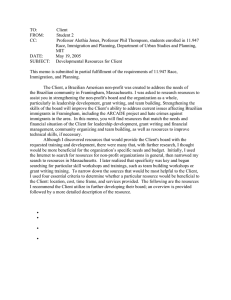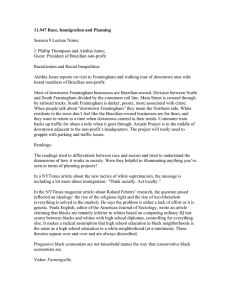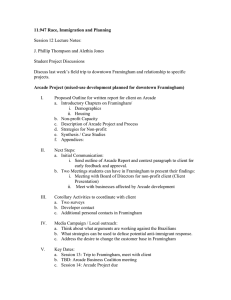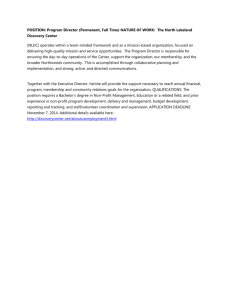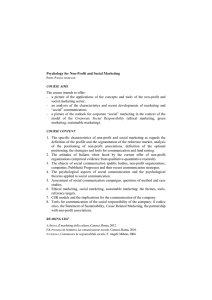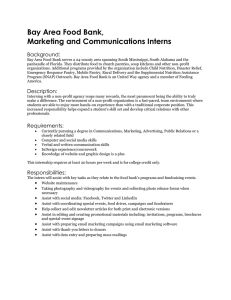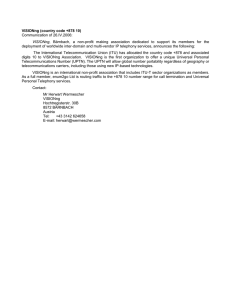11.947 Race, Immigration and Planning Session 10 Lecture Notes:
advertisement
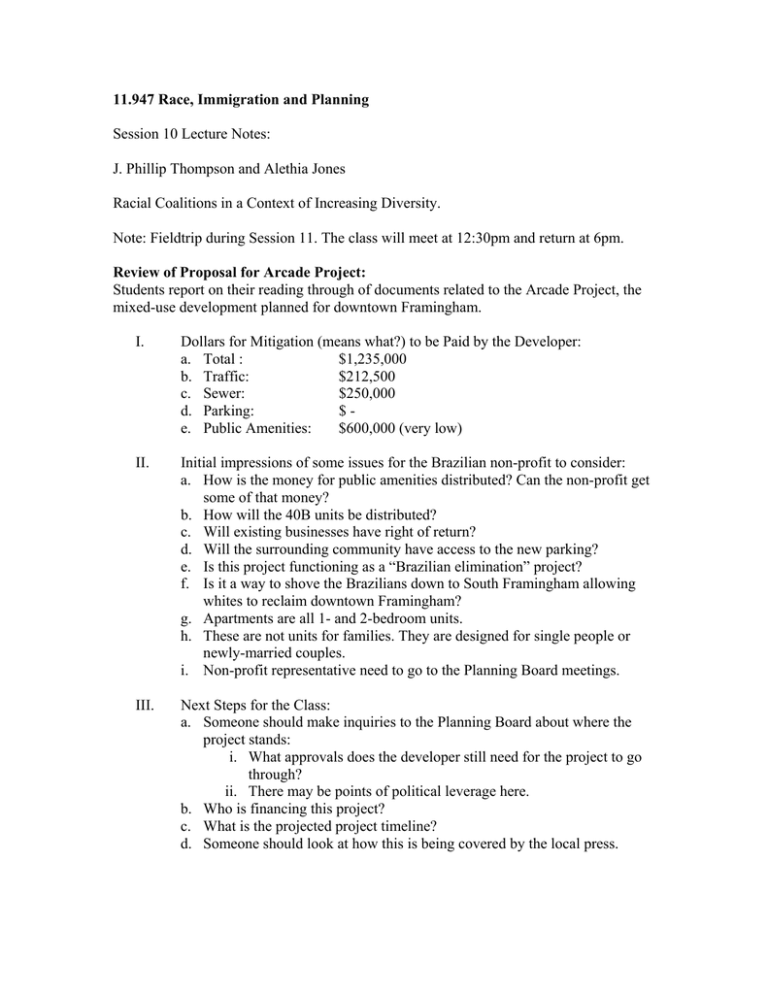
11.947 Race, Immigration and Planning Session 10 Lecture Notes: J. Phillip Thompson and Alethia Jones Racial Coalitions in a Context of Increasing Diversity. Note: Fieldtrip during Session 11. The class will meet at 12:30pm and return at 6pm. Review of Proposal for Arcade Project: Students report on their reading through of documents related to the Arcade Project, the mixed-use development planned for downtown Framingham. I. Dollars for Mitigation (means what?) to be Paid by the Developer: a. Total : $1,235,000 b. Traffic: $212,500 c. Sewer: $250,000 d. Parking: $e. Public Amenities: $600,000 (very low) II. Initial impressions of some issues for the Brazilian non-profit to consider: a. How is the money for public amenities distributed? Can the non-profit get some of that money? b. How will the 40B units be distributed? c. Will existing businesses have right of return? d. Will the surrounding community have access to the new parking? e. Is this project functioning as a “Brazilian elimination” project? f. Is it a way to shove the Brazilians down to South Framingham allowing whites to reclaim downtown Framingham? g. Apartments are all 1- and 2-bedroom units. h. These are not units for families. They are designed for single people or newly-married couples. i. Non-profit representative need to go to the Planning Board meetings. III. Next Steps for the Class: a. Someone should make inquiries to the Planning Board about where the project stands: i. What approvals does the developer still need for the project to go through? ii. There may be points of political leverage here. b. Who is financing this project? c. What is the projected project timeline? d. Someone should look at how this is being covered by the local press. IV. e. Someone should try to get the minutes from the public hearings. There may be other potential allies for the Brazilians who do not want the project. f. After the visit, there should be a strategy session. g. Students should create a memo to the non-profit about the various sources of funding at MIT. It would also be useful to look for model agreements that have been worked out in other communities. a. In Lawrence, a Latino Business Council was formed to develop greater political capital; it eventually phased out. b. In Hyde Park/Jackson Square, a strong Latino Merchant Council had a major role in starting the Main Streets project there. V. Public Hearings (6): a. January 27, 2004 b. February 17, 2004 c. March 9, 2004 d. March 18, 2004 e. March 23, 2004 f. March 25, 2004 VI. Underlying Issues: a. Small towns like Framingham are desperate for money, so they want new taxpayers to come in; they will take virtually any development project that comes along. b. The developer is giving back very little to the city. The plan has gone through the approvals process. No information about the timeline. Many of the businesses and residents don’t know: 1. the scope of the plan, 2. that it requires them to leave, 3. when everything will happen. c. There needs to be a meeting of different immigrant groups who are dealing with these issues in different suburban areas across the region and state. If you could get groups together from a number of different areas, it might be possible to get more attention from the Commonwealth of Massachusetts. i. If the business owners are angry and willing to organize other business owners, then that carries an amount of political currency that other groups don’t have. VII. Class deliverable: a. Give some basic suggestions for what the non-profit can do in response to the plan b. Gather models for them to work toward c. Find sources of money to support the Brazilian community’s work d. Clear and transparent narrative of the process, issues, and action items. e. Sit down with the non-profit and explain the process, why it is important to go to these meetings and what to say at the meetings. Class Discussion (Readings and Video): IX. Reactions to Farmingville: a. What do people think that racism is? b. Is it possible to be critical of day-laborers and not be racist? c. The framework of the opposition to the immigrants was “We’re protecting our community and our way of life.” d. Groups can be built around active ignorance of this type. X. XI. Political Legacies: a. Amartya Sen: i. In India, the tradition of argumentation, tolerance for dissent, goes back 3500 years in politics and religion as well as loquaciousness in speech and writing. ii. India has a very long intellectual tradition of philosophical reflection and debate on intellectual and spiritual issues. The United States doesn’t have that. b. De Toqueville: i. 1840: Claimed that Americans are politically lazy and that democracy promotes that. Everyone gets equal votes, so there is no incentive to be industrious in politics because there is no individual reward. ii. He predicted that Americans would be very petty and uninterested in politics. iii. He predicted that American government would become a kind of soft-despotism. It would be kind to the middle class. c. Castells’ Defense of Localism: i. The importance of having alternative narratives. 1. What are urban social movements doing to reframe the issues? 2. There is work to be done on the pro-immigrant side around strengthening that narrative: strengthening, redefining, reframing the issue. American Legacies of Race a. In America, where is the educational voice popularly to create factions that support immigrants? i. Who is speaking to them? ii. Liberals aren’t speaking out on these issues. iii. Outside the context of an understanding and a struggle that you invite immigrants and native-born Americans to engage in together, you have a lot of fighting. iv. Unless you have a framework by which they can fight against the injustice together, the fighting will be endless. b. Where is the place for these issues to be addressed and discussed without becoming racialized? c. How do you fight the force of globalization? i. It is an airy, vague issue. ii. How do you change the concept of globalization so that people can move against globalization? iii. The only bodies that pro-immigrant groups have to fight are the anti-immigrant people. Anti-immigrant forces can attack the concrete form of the immigrant. XII. Current Debates: a. Globalization: i. The debate going on right now of really taking on Wal-mart is about this. ii. It is a concrete target in 2000 communities, it is huge, it epitomizes these larger processes. iii. It really could be a successful campaign. b. Immigration and Racialization: i. The burden is on the pro-immigrant groups to name when an issue is being racialized and how and reframing it in another way so that it is not. ii. In Farmingville, the pro-immigrant group was framing the issue such that other problems weren’t addressed. There was an absence of flexibility in the solution. Could the hiring hall have been funded by some of the businesses that were benefiting from the labor? iii. You can’t win sympathy for low-income workers across race in America unless you deal with race. Americans don’t care about immigrants or people they do not see as part of their communities. It is very difficult to understand how the other feels.
